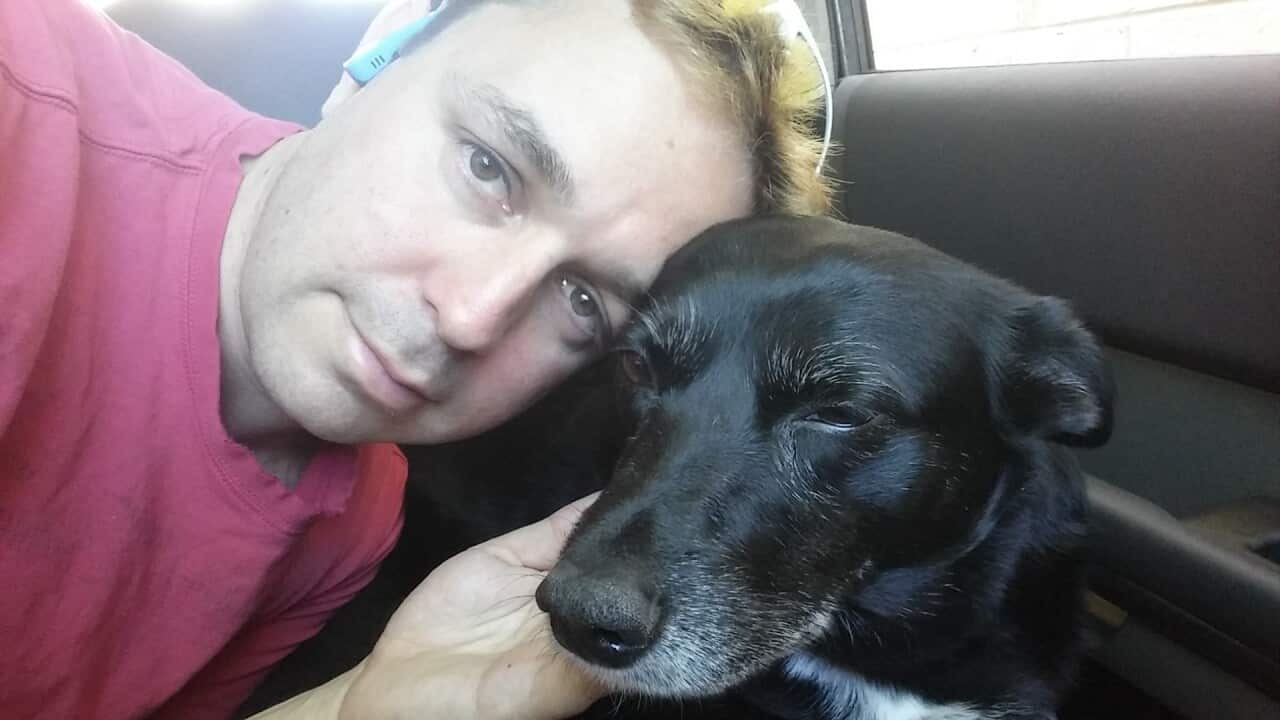It's supposed to be one of life's certainties: grieving your pet when they die. But when Dale Pearce found out that his dog’s cancer diagnosis meant she had months to live, it was a certainty he didn’t want to accept.
“I had my dog frozen in hopes that I could bring her back one day,” Dale told The Feed.
“I hated seeing that, after all those years that we’ve been together…you just have to keep telling yourself you’ve given them a chance.”
Dale and his pet kelpie of 10 years, Neren, were inseparable. The pair travelled around Australia, went to music festivals and events, and once starred in an indie horror film together. Before Neren came into his life, Dale said he was often lonely and struggled to stay motivated.
“Having a dog nagging me in the morning to get out and about - it keeps me going,” he said.

Neren and Dale enjoyed going to the beach together. Source: Supplied / Dale Pearce
“I knew that I may have to watch her die in my hands…but I didn’t want that,” Dale said.
Dale began researching his options online.
That’s when he found the Cryonics Institute: a US-based facility preserving the bodies of people and pets, claiming there was a chance they could be revived from the dead one day.
Dale travelled with Neren to the US, where he paid $US 20,000 (almost $30,000) to have her body placed into deep freeze.
Dale is hopeful he will be reunited with his beloved dog by the year 2050.
“Maybe, as technology improves over the decades, we could be back together [for] more adventures,” Dale said.
What is cryonics?
Cryonics is preserving bodies at extremely low temperatures in hopes they can be resurrected in the future.
To cryonically preserve a pet:
- The animal is euthanised by a vet and placed on ice to cool down
- Water is removed from the body and replaced with a chemical that acts as antifreeze
- The body is cooled down further, then placed in a tank of liquid nitrogen
- There it remains in storage, at around -200 degrees Celsius.
Supporters of cryonics are hoping as technology improves, there may come a time when frozen pets can be thawed out and restored to life in a young, healthy and disease-free body.

Neren visiting the cryostat (insulated tank) where she is now stored. Source: Supplied / Dale Pearce
Is it possible to resurrect a pet after it’s been frozen?
Since the first person (US psychology professor James Hiram Bedford) was cryonically preserved in 1967, hundreds of people and pets have had the procedure done – but none have been brought back so far.
Many scientists have doubts about whether cryonics will work.
Saffron Bryant is a researcher at RMIT University who studies cryopreservation – the science of cooling biological samples.
“At this stage, the science doesn't support cryonics,” Saffron said.

Saffron Bryant is a scientist who is doubtful cryonics will work. Source: SBS
“We can't store tissues, we can't store organs, and we certainly can't store whole organisms at the moment,” Saffron said.
Saffron explained when something is frozen, ice crystals form and destroy the cells, unless special chemicals are added.
“The trouble is that this cryoprotective agent that we currently use is actually quite toxic,” she said.

The Cryonics Institute is one of the largest cryonics companies in the world. Source: Supplied / Cryonics Institute
Saffron is also wary of cryonics’ claim that pets can be brought back to life once the cures to their diseases have been found.
“If someone dies from an infection, it's no good then giving them the antibiotics. It won't help them,” she said.
Australia’s first cryonics facility
The option to freeze your pet in Australia may soon become a reality. The first cryonics facility in the southern hemisphere has set up shop in Holbrook, a country town in southern NSW.
Southern Cryonics director Peter Tsolakides says the company is planning to preserve pets on a case-by-case basis.

The Southern Cryonics facility in NSW has recently finished construction. Source: Supplied / Southern Cryonics
“I think the market could be quite big.”
Despite the scepticism towards cryonics, Peter said he’s offering clients a chance of being reunited with their loved ones.
“The alternative is burial or cremation, and there's zero chance,” he said.
How much does it cost to freeze your pet?

Dale hopes to be reunited with his dog one day. Source: Supplied / Dale Pearce
“A cat, I think, is about five to five to six kilos…it's roughly $10,000,” Peter said.
“If it was a big dog, as big as a human, it would almost cost the size of a human.”
It took Dale a few years to recover financially, after spending the money to freeze his dog.
“I was happy to pay this for Neren, and I don't regret it now,” Dale said.
“I like the odds of her coming back.”










